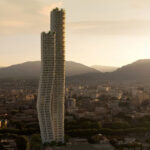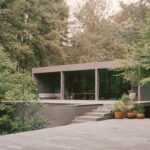
The Thin-Shell Metal Woven Pavilion, an architectural marvel situated over a serene pool, offers a tranquil retreat that shelters visitors from wind and sun while inviting natural light into its thoughtfully designed interior. Envisioned by XISUI Design, it represents a breakthrough in digital metal construction, embodying a harmonious blend of nature-inspired aesthetics and advanced engineering.
DESIGN
Inspired by the intricate weaving of bird nests and the structural integrity of eggshells, the pavilion’s segmented metal shell is both an artistic and engineering feat. The design features an ultra-thin shell and a centripetal dome, creating a pure and serene environment that encourages contemplation and peace.

Spanning 11 meters over the water, the pavilion was constructed using minimal materials and manual labor, showcasing innovative design and fabrication techniques. Continuous computational testing by interdisciplinary teams enabled the exploration of new possibilities in design, engineering, and fabrication.
Typically, a pavilion with an 11×8 meter span requires a substantial supporting framework. This project challenges that convention with a keel-free design, achieved through a doubly curved structure that relies solely on a thin shell surface for load-bearing.
Wind and gravity load calculations demonstrated that just two layers of 2.5 mm thick metal plate segments were sufficient to achieve a span 4,400 times their thickness. This efficient structural form distributes loads effectively, utilizing principles similar to ancient vaulted buildings and natural bird eggshells. The result is a stable and efficient structure that minimizes material usage while maintaining aesthetic integrity and elegance.

A dedicated application was developed for curvature analysis, deformation calculation, and surface subdivision. The entire hyperboloid structure is divided into 469 bespoke metal segments of varying sizes. Through digital design and fabrication, these segments are precisely designed to fit together seamlessly, ensuring efficient processing and assembly.
The pavilion features welding-free construction, with all shell segments pre-fabricated using CNC machinery, numbered, and delivered to the site for precise assembly. This method eliminates the need for extensive positioning keels and formwork, allowing a small team of craftsmen to assemble the entire structure efficiently. This integrative digital approach reduces labor costs and elevates the caliber of craftsmanship, ensuring the doubly curved geometry boasts a visually fluid and gentle appearance.
During construction, traditional manual welding techniques were replaced with bolts for point-to-point alignment and high-precision milling. This technique ensures accuracy in the final form and prevents common errors associated with manual manufacturing, such as cumulative errors from manual positioning and welding heat-induced deformation of thin plates.
This approach also imparts flexibility to the pavilion, allowing for easy replacement of components or even relocation of the entire structure. All building modules are designed for disassembly and reuse at different sites, enhancing the project’s sustainability and giving the pavilion a sense of continuity and permanence.

First assembled in 2020, the pavilion was relocated in 2023, transitioning from a temporary exhibition to permanent use. This relocation achieved considerable cost savings and reduced material waste, further emphasizing the project’s innovative and sustainable approach.
Visitors are guided along a sunken passage below the pool to the Thin-Shell Metal Woven Pavilion, enhancing their relaxation as they approach the serene space. This secluded path provides partially open and private spaces, enriching the sensory experience and stimulating visitors’ imagination of nature.
Numerous tiny openings are carefully embedded between the woven gaps, allowing light to penetrate the interior and form a luminous array. These spots of natural light create dynamic patterns that reflect the structural streamlines on the dome, changing throughout the day with the movement of sunlight and cloud cover.
The pavilion’s exterior, painted white, reflects on the water’s surface, creating a serene and pure aesthetic. The interior, with its matt brown-gold walls, reduces light reflection and immerses visitors in an experience akin to exploring a deep cave. Inside, the centripetal dome and surrounding pool evoke sensations of being enveloped by mountains and the sea, while the dome’s acoustics amplify normal speaking volumes, providing an environment conducive to introspection and reflection.
The Thin-Shell Metal Woven Pavilion offers urban dwellers a tranquil space for contemplation, away from the hustle and bustle of city life. It fosters an atmosphere that promotes meditation and inner peace, making it a unique and valuable addition to modern architectural landscapes.

Official Project Name: Thin-Shell Metal Woven Pavilion
Location: Hefei City, Anhui Province, China
Client: Yango Group Co., Ltd. Hefei
Size: 11 by 8 meters
Design & Build: XISUI Design
Chief Designer: Yihao Hu
Project Manager: Yang Peng
Structural Consultant: Spiring Architectural Design
Suppliers: Shanghai ZhouJie Metal Decoration Engineering Co., Ltd., Shanghai Zhan Jing Construction Engineering Co., Ltd.
Project Sector: Landscape Installation
Budget: CNY 1,000,000
First Completion Date: October 1, 2020
Relocation Completion Date: April 20, 2023
Photographer: Yihao Hu, Jia Liu, Fancy Images




wow this is sublime! China is really pushing the boundaries of contemporary architecture, I am not seeing it explored anywhere else within cultural projects industry as in China!